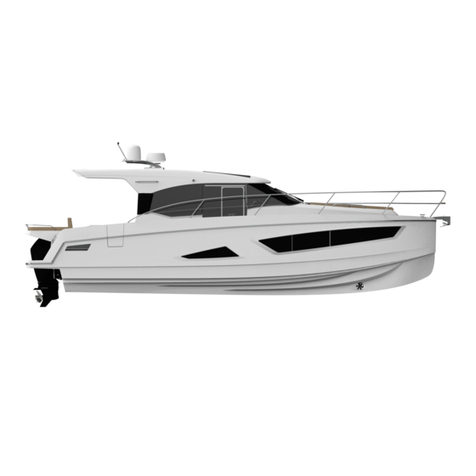www.parkerboats.net
4
OWNERS ORIENTATION
Orientation ................................................................ 6
Warranty Information ..........................................7-8
Hazard Warning Symbols ....................................... 8
Dealer Pre-delivery/Delivery Responsibilities.... 9
Consumer Responsibilities .................................... 9
Boat Model Identification..................................... 10
BOATING SAFETY
Required Safety Equipment ................................ 11
Fire Extinguisher .................................................... 11
Sound Signaling Devices ..................................... 11
Visual Distress Signals .......................................... 11
Additional Recommended Equipment .............. 12
Emergency Information ................................. 14-15
Emergency Stop Switch ........................................ 16
Rendering Assistance ........................................... 16
Accident Reporting ............................................... 16
Boating Safety Tips................................................. 17
Basic Rules of the Water ................................. 18-19
Loading Capacity.................................................... 20
Carbon Monoxide .................................................. 20
Suggested Boating Classes and Literature........ 21
GENERAL BOATING INFORMATION
Fuel System Information ...................................... 22
Fueling ..................................................................... 23
Discharge Regulations ......................................... 24
Discharge of Oil ..................................................... 24
Disposal of Plastics and Other Waste................. 24
Driving ...................................................................... 25
Trailering ............................................................ 25-26
Pre-start Checklist.................................................. 27
Leaving/Approaching the Dock ......................... 27
Towing or Being Towed ........................................ 28
Shallow Water.................................................... 28-29
Anchoring ............................................................... 29
Using a Windlass..................................................... 29
General Information on Boat Handling ............. 30
Common Nautical Terms....................................... 31
PERFORMANCE
Performance Factors.............................................. 32
Engine Efficiency ................................................... 32
Weather Conditions ............................................... 32
Load Distribution .................................................. 32
Marine Growth ....................................................... 32
Trim ........................................................................... 32
Propeller................................................................... 33
Propeller Terms ....................................................... 33
Outboard Propulsion System............................... 33
Engine Systems....................................................... 34
Engine Warranty ..................................................... 34
Throttle/Shift Control ........................................... 34
Neutral Safety ......................................................... 34
Shift Function ......................................................... 34
Throttle Function.................................................... 34
Forward Throttle..................................................... 34
Reverse Throttle ..................................................... 35
Neutral Throttle ...................................................... 35
Stopping/Braking ................................................... 35
Control Cables ........................................................ 35
Steering .................................................................... 35
Hydraulic Steering.................................................. 36
Trim Tabs ................................................................. 36
GAUGES AND SWITCHES
Yamaha Analog Gauges ........................................ 37
Yamaha Digital Instrumentation ......................... 37
Multi-Function Tachometer ................................. 37
Multi-Function Speedometer .............................. 37
Tachometer ............................................................. 37
Speedometer........................................................... 37
Fuel Gauge............................................................... 37
Usable Fuel .............................................................. 37
Trim Gauge .............................................................. 38
Voltmeter ................................................................. 38
Engine Lubrication ................................................ 38
4-Stroke Engines .................................................... 38
Warning Systems .................................................... 38
Water Temperature and Oil Level........................ 38
Clock ......................................................................... 39
Fuel Gauge............................................................... 39
Low Fuel Warning Indicator ................................. 39
Overheat Warning Indicator................................. 39
Trip Meter................................................................. 39
Oil Level Warning Light ........................................ 39
Revolutions per Minute (RPM) ............................ 39
Trim .......................................................................... 39
Switch Panel ........................................................... 40
Bilge Pump .............................................................. 40
Cockpit Lights ........................................................ 40
Horn .......................................................................... 40
Livewell..................................................................... 40
Washdown .............................................................. 40
Navigation/Anchor Lights ................................... 40
Accessory ................................................................ 40
Circuit Breakers ...................................................... 40




























